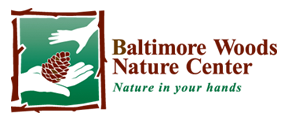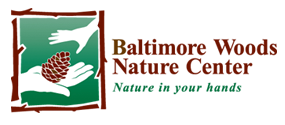Week of September 21, 2025 – September 27, 2025
by Elizabeth Suzedell, Environmental Educator
When you are out in nature, how often do you find something new that you don’t know what it is? Even though I’ve spent a lot of time exploring the trails at Baltimore Woods, I’m always finding new plants, mushrooms, and bugs that I have never seen before. I like to use field guides to help me figure out what I’m seeing, but they are limited- and sometimes, I don’t even know whether the thing I’m seeing is a fungi or insect eggs! For moments like this, I often turn to iNaturalist, which is an amazing online resource that helps people figure out what they are seeing in nature.
iNaturalist is a citizen science project where people can submit photo observations of plants, animals, fungi, or any other form of life that they see outdoors. Photos of a species, along with the date, time, location, and any other information the user would like to include, are uploaded to iNaturalist’s online database of over 275 million observations. The computer can help users figure out what kind of species they found, and then other users on the platform verify the identifications. Once an observation has gotten enough agreeing identifications, it becomes “research grade,” meaning scientists can use the data from that observation in their projects.
iNaturalist is a great tool to help you learn about the biodiversity in your community. It is great for identifying your own observations of nature, but it is also a place to explore what other people have seen in your area. Baltimore Woods Nature Center has its own project, which is a collection of over 6000 observations that visitors have made on the property. After looking at observations on the project, I was able to answer some questions that I was curious about. I found out that we do, in fact, have walking sticks at Baltimore Woods (specifically blatchley walkingsticks), there are at least eleven species of asters that we could see blooming here in the fall, and I was not the only one to be filled with wonder about the bright orange mycena mushrooms I saw last year.
Anyone can participate in iNaturalist, including you! You just need a camera (phone cameras work great), and an internet connection. While outside, whether you are in the forest or the city, take pictures of any living thing that you’d like that is naturally occurring (not planted in a garden or someone’s pet). It can be the creature itself, or evidence of the creature (tracks, scat, a feather, seeds, etc.). Post your observation to iNaturalist on the phone app, or on the computer. If you are knowledgeable about a certain group of species, add identifications to other peoples’ observations to help make them “research grade.” Remember to be respectful to nature (don’t trample on or hurt creatures for the sake of a photo), and if you think you have found a rare species, make sure to “obscure” your observation’s location. I hope you have fun, and learn some cool things about nature along the way!
For more information about iNaturalist, go to: https://www.inaturalist.org/
Explore the Baltimore Woods iNaturalist project at: https://www.inaturalist.org/projects/baltimore-woods-nature-center


